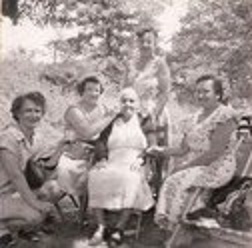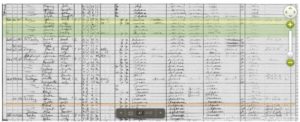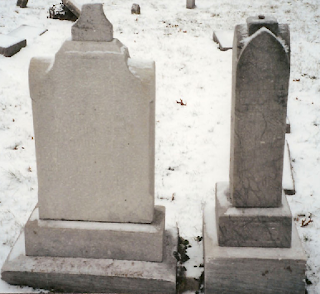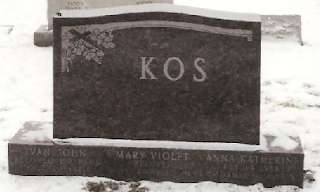Originally published on genealogyatheart.blogspot.com on 26 Jul 2015.
I have fond memories of picnics – beginning in childhood all the way to last weekend! Picnics today are a relaxed affair, it’s a wear something comfortable, de-stress and enjoy family, friends and nature. I don’t know about you but I definitely don’t try to make a fashion statement when going on a picnic. That wasn’t the case, however, back in the day. I love the picture below showing my grandmother, Non, with the family’s first car in 1923. Nice touch with the American flag on the front since it was Independence Day. They were on their way to the Croatian Picnic Grounds located between Glen Park and Hobart, Indiana. A dress, heals and Sunday’s best hat for spending the day in the sticks.
 |
| July 4, 1923-on the way to a picnic, L-R Boarder, Mary Koss, Joseph Koss Jr. |
Non wasn’t alone in her wearing apparel. You’d think the family was going to church instead of spending the day in the woods.
 |
| Croatian Picnic Grounds 1923 L-R George Kos, Anne Marie Koss, Anna Grdenic Kos, Ivan “John” Koss, Dorothy Koss, Mary Koss and Barbara Kos |
| Must have been a chore to get the kids’ clothes clean! The area was heavily wooded with a small clearing that was mostly dirt. No wonder Non loved her Fels Naptha laundry soap. We had an old Maytag ringer washer in the basement that had to be filled up by hand with hot water. I can still picture my Gramps hooking up the laundry line around our backyard and adding poles with slits to insure that the line didn’t sag. Monday was wash day and the picnic sure must have been a distant memory the following day spent cleaning all those dirty garments.
The Croatian picnic grounds were used for at least 50 years. The picnic grounds were open on Sundays from Memorial Day through Labor Day. Every Sunday, one of the men would rise early to attend 6 AM Mass and then set off for the grounds to prepare the spit that would roast the lamb. Families took turns selling plates of food and drinks. Our shift was usually 1-2 PM once a month. I wish I had a picture of the building which was just a wooden shack. The north end was enclosed to hold supplies. That was attached to a covered bar area. Since the bar rail was too high for kids, a child who was helping would stand on an overturned wooden “pop” or soda carton or two. Customers would order plates of roasted lamb, Vienna style bread, Croatian style potato salad or a lettuce salad with oil and vinegar dressing. Drinks were always Budweiser beer in a bottle or whatever pop was on sale that week – Coke, Pepsi, Fanta, Sprite. Funny we never had water though there was a spigot that we all used to wash our hands after eating. Someone would put a bar of soap in a mesh bag on a string around the spigot. Nature dried our hands. I have no memory of the bathroom facilities, if they even existed. Some of the ladies brought desserts to sell – pita which is like a fruit filled bar cookie and not the bread sold today, apple or cheese strudel, and cookies. Both lunch and dinner was served. Sometimes the menu changed and pork was included, along with hamburgers and hot dogs. We always got lamb, though, which was heavenly. My father-in-law disliked lamb as he believed it was tough and tasteless. My last visit to the Croatian picnic grounds was in 1985 when my husband and I returned to visit his family. We brought a takeout container to my in-laws and after one bite, my father-in-law groaned that he had spent his entire life in the area and never knew what he had been missing. The following Sunday he went back for more. After lunch, as kids, we’d cut through the woods on a well worn trail or crossed the street to visit our school friends and neighbors of other nationalities. My next door neighbor, Carol Leon, would be at the Spanish picnic grounds right across the street. There was also Polish, Serbian, Greek, and Italian grounds. Possibly there was more but I wasn’t allowed to walk that far! Sometimes we’d play baseball or badminton with our friends but our favorite was cigarette tag – Someone was “it” and “it” chased everyone around. If you were tagged you had to sing a cigarette jingle (like, Winston, tastes good like a cigarette should or I’d walk a mile for a Camel) or you became “it.” Funny but none of us grew up to be smokers. The adults spent the afternoon playing horseshoes or cards. The women loved to gossip. There was also singing and dancing (after a couple of beers) as the musically inclined always brought their native instruments. By the mid 1960’s female children began wearing shorts. The ladies continued to dress up through the early 1970’s. |
 I wish I had the secret lamb recipe, I know it was infused with garlic, probably patted down with salt and pepper but what else I have no idea. I do make the Croatian potato salad often which is similar to German potato salad. Besides lamb, it’s wonderful with ham, too. Try it and let me know what you think: |
Croatian Style Potato Salad
Peel and cube potatoes to bite size (I use red but any kind will do) about 2 potatoes per person.
Add water and cook on stove til tender.
Meanwhile, cut a small sweet onion coarsely.
When potatoes are done, drain and place into a large serving bowl. Liberally sprinkle with coarse salt and pepper. With a serving spoon, mix then salt and pepper some more. Add the onions. Using a ratio of 1 tablespoon red wine vinegar (or regular vinegar) to 2 tablespoons oil (vegetable or light olive) drizzle over the potatoes/onions until the potatoes are well saturated. Gently stir to make sure that all of the liquid is absorbed. If you have fresh dill or parsley you can add either. Put a dinner plate over the serving bowl to maintain the heat and allow the dish to marinate, about 5 minutes. When ready to serve, stir and enjoy!










